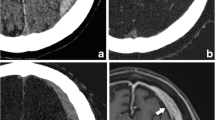Summary
Calcification of chronic subdural haematoma is called “armoured brain” when it covers most of the cortical surface. We report high-field magnetic resonance images of the armoured brain, and discuss the relationship between operative findings, computer assisted tomographic (CT) findings and the change in relaxation time on magnetic resonance images. In our case, low, iso, and high density layers were detected on computer assisted tomography. The change in relaxation time of a liquefied haematoma showed good agreement with chronological change in intracerebral haematoma, and the material was easily detected on magnetic resonance images. But with a grainy and mud-like haematoma, the change in relaxation time did not coincide with the state of the intracerebral haematoma.
It is generally said that in the detection of a calcified mass, computer assisted tomography is superior to magnetic resonance images and this was also true in the present case. While there are a few reports on computer assisted tomographic findings for the armoured brain, this is probably the first report on high-field (1.5T) magnetic resonance imaging of the armoured brain.
Similar content being viewed by others
References
Birkner R, Lageman K (1966) Ausgedehnte Verkalkungen bei Pachymeningitis haemorrhagica interna and Haematoma subdurale. Über einen Fall von “Panzerhirn”. Rofo 105: 377–381
Ludwig B, Nix W, Lanksch W (1983) Computed tomography of the “armored brain”. Neuroradiology 25: 39–43
Matsumoto M, Nojiri K (1984) A symptomatic calcified chronic subdural haematoma in the elderly. Neurol Med Chir (Tokyo) 24: 505–506
Niwa J, Nakamura T, Fujishige M, Hashi K (1988) Removal of a large asymptomatic calcified chronic subdural haematoma. Surg Neurol 30: 135–139
Spadaro A, Rotondo M, Di Celmo D, Simpatico S, Parlato C, Zotta DC, Albanese V (1987) Bilateral calcified chronic subdural haematoma. Further pathogenic and clinical consideration on the so-called “Armoured Brain”. J Neurosurg Sci 31: 49–52
Gomori JM, Grossman RI, Goldberg HI, Zimmerman RA, Bilaniuk LT (1985) Intracranial haematomas: Imaging by highfield MR. Radiology 157: 87–93
Author information
Authors and Affiliations
Rights and permissions
About this article
Cite this article
Yamada, K., Ohta, T., Takatsuka, H. et al. High-field magnetic resonance image of a huge calcified chronic subdural haematoma, so-called “armoured brain”. Acta neurochir 114, 151–153 (1992). https://doi.org/10.1007/BF01400606
Issue Date:
DOI: https://doi.org/10.1007/BF01400606




